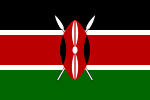 Abagusii people singing and dancing while playing a native harp (aka Obokano) | |
| Total population | |
|---|---|
| 2,703,235[1] | |
| Regions with significant populations | |
| Languages | |
| Ekegusii | |
| Religion | |
| Christianity, Traditional Beliefs, Islam | |
| Related ethnic groups | |
| Abakuria,[2] Ameru,[3] Embu,[3] Kikuyu,[3] Mbeere,[3] Kipsigis,[4] Maasai[4] Linguistic-Relationship:Ngurimi,[2] Zanaki,[3]Ikoma,[3]Rangi,[2] Mbugwe,[2]Simbiti.[2] Maragoli[3] and Suba people (Kenya)[3] |
| Gusii (Goosie) | |
|---|---|
| Person | Omogusii |
| People | Abagusii |
| Language | Ekegusii |
| Country | Gusii |
| Part of a series on the |
| Culture of Kenya |
|---|
 |
| Cuisine |
The Abagusii (also known as Kisii (Mkisii/Wakisii) in Swahili, or Gusii in Ekegusii) are a Bantu ethnic group indigenous to Kisii and Nyamira counties of former Nyanza, as well as parts of Kericho and Bomet counties of the former Rift Valley province of Kenya.
The Abagusii traditionally inhabit Kisii and Nyamira counties, as well as sections of Kericho and Bomet counties, all of which were within the former Nyanza and Rift Valley provinces of Kenya. Studies of East African Bantu languages[2] and anthropological evidence suggests that the Abagusii, together with Kuria, Ngurimi, Rangi, Mbugwe, Simbiti, Zanaki and Ikoma, emerged from East African Neolithic agropastoralists and hunters/gatherers[5][6][7] believed to have come from the North of Mt. Elgon.[3] It's also believed that there was heavy influence on the Abagusii from Bantu speakers migrating out of Central Africa and West Africa; certain groups of the Abagusii may have been assimilated from the Luhya and Olusuba speaking Suba people, which originated from west of Lake Victoria.[8] The majority of Abagusii are closely related to the Maasai, Kipsigis, Abakuria, and Ameru of Kenya.
The Abagusii also have a close linguistic relationship with the Ngurimi, Rangi, Mbugwe, Simbiti,[2] Zanaki, Ikoma and Maragoli people. They speak the Ekegusii language which is classified with the Great Lakes Bantu languages. However, the inclusion of Abagusii in the Bantu language group is a subject of debate, given that studies on East African Bantu languages have found Ekegusii, together with the Kuria, Simbiti, Ngurimi, Rangi and Mbugwe languages to be rather distinct from other Bantu languages in terms of structure and tense.[2]
- ^ "2019 Kenya Population and Housing Census Volume IV: Distribution of Population by Socio-Economic Characteristics". Kenya National Bureau of Statistics. Retrieved 24 March 2020.
- ^ a b c d e f g h Gibson, Hannah (2019). "The grammaticalisation of verb-auxiliary order in East African Bantu From information structure to tense-aspect" (PDF). Studies in Language. 43 (4): 757–799. doi:10.1075/sl.17033.gib. S2CID 204479937.
- ^ a b c d e f g h i Ochieng, W.R. (1972). "'Misri' Legends in East and Central Africa". East Africa Journal.
- ^ a b Omwoyo, Samson Moenga (2000). The Agricultural Changes in the Kipsigis Land, c. 1894–1963: An Historical Inquiry (Thesis).
- ^ Ehret, C. (1980). The historical reconstruction of Southern Cushitic phonology and vocabulary. Kölner Beiträge zur Afrikanistik. Vol. 5. Berlin: Reimer. ISBN 9783496001041.
- ^ Ambrose, S.H (1982). "Archaeological and linguistic reconstructions of history in East Africa". In Ehert, C.; Posnansky, M. (eds.). The archaeological and linguistic reconstruction of African history. University of California Press. ISBN 9780520045934.
- ^ Ehret, C. (2002). The Civilizations of Africa: a History to 1800. University Press of Virginia. ISBN 0-8139-2085-X.
- ^ Okello, Ayot. A History of the Luo-Abasuba of Western Kenya, from A.D. 1760–1940.